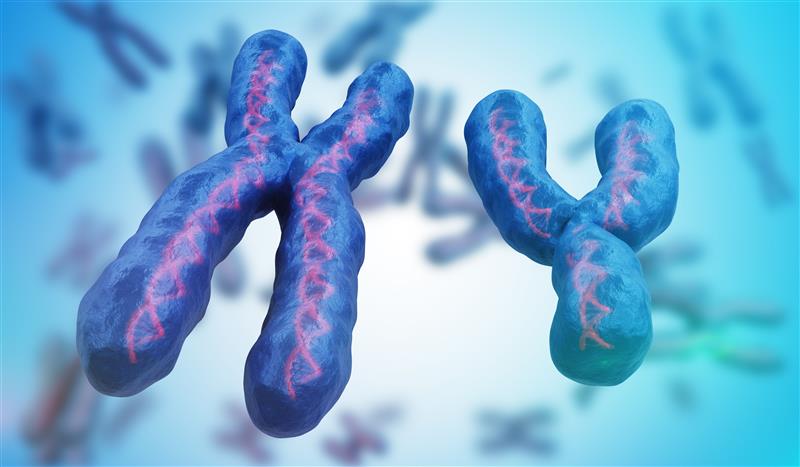To understand what sex chromosome aneuploidy is, it’s important first to understand some basic genetics vocabulary. Aneuploidy is a condition where a cell has an atypical number of chromosomes.
Typically, humans have 46 chromosomes; 23 from the sperm and 23 from the egg, arranged into pairs. The 23rd pair is called the sex chromosomes, because they determine the biological sex of the baby. Usually, females have two X chromosomes and males have one X and one Y chromosome. Sometimes random changes can happen resulting in a missing or an extra sex chromosome, called monosomy or trisomy, respectively.1
Sex chromosome aneuploidies (SCAs) affect up to 1 in 400 newborns.2 The most common SCAs are monosomy X (Turner syndrome), trisomy X (XXX syndrome), Klinefelter syndrome (XXY syndrome), and Jacobs syndrome (XYY syndrome). Some people with sex chromosome conditions have no symptoms while others can have serious health issues.
- Monosomy X (Turner syndrome) occurs in about one in 2,000-2,500 girls. Girls with Turner syndrome tend to be shorter, don’t go through typical puberty, and may have health problems affecting their organ systems, like heart or kidney problems.3
- Trisomy X (XXX syndrome) affectsabout one in 1,000 girls. Many girls and women with trisomy X don’t experience any symptoms or only have mild symptoms. Others experience symptoms that may include developmental delays and learning disabilities.4
- Klinefelter syndrome (XXY syndrome) occurs in about one in 500 males. It may result in less testosterone, and people with Klinefelter syndrome typically produce little to no sperm. However, only about 25% of males with this syndrome are diagnosed, and their diagnosis usually occurs in adulthood. 5
- Jacobs syndrome (XYY syndrome) happens in about one out of 1,000 boys. Boys with XYY syndrome may be taller than average and have increased chance of anxiety, depression, learning disabilities, ADHD, and other behavioral challenges.6
In general, SCAs occur randomly and cannot be prevented. There are no cures for SCAs. Treatments vary based on the SCA and on each person’s symptoms. Treatments might include physical or occupational therapy and mental health services, as well as hormone therapy.
The benefits of detecting sex chromosome aneuploidies early
A good way to learn about SCAs as early as possible is through prenatal cell-free DNA (cfDNA) screening, which can be done as early as eight weeks into your pregnancy.
CfDNA screening is done through a regular blood test where small fragments of DNA from your pregnancy are analyzed. Results are available about one week after the blood test.
Most screening results will show that your baby has a low risk of having a sex chromosome condition. But if your screening shows a higher-risk result, you can discuss it with your healthcare provider and a genetic counselor. Follow-up diagnostic testing to confirm the results are available during pregnancy, such as an amniocentesis or chorionic villus sampling, or with a blood test after delivery.
While SCAs can’t be prevented, if you know about them in advance, you can prepare and plan in consultation with your healthcare provider. You can understand possible symptoms, learn about treatments, and find experts in your community who can provide resources to you and your child.
References
- Cleveland Clinic. Aneuploidy: Genetic Disorder Causes & Types. Cleveland Clinic. https://my.clevelandclinic.org/health/diseases/24060-aneuploidy. Accessed June 16, 2025.
- Reimers R, High F, Kremen J, Wilkins-Haug L. Prenatal diagnosis of sex chromosome aneuploidy—what do we tell the prospective parents? Prenat Diagn. 2022;43(2):250-260. Doi:10.1002/pd.6256. https://obgyn.onlinelibrary.wiley.com/doi/10.1002/pd.6256. Accessed April 15, 2025.
- Stanford Medicine Children’s Health. Turner Syndrome (Monosomy X) in children. https://www.stanfordchildrens.org/en/topic/default?id=turner-syndrome-monosomy-x-in-children-90-P02421. Accessed April 15, 2025.
- Mayo Clinic. Triple X syndrome. https://www.mayoclinic.org/diseases-conditions/triple-x-syndrome/symptoms-causes/syc-20350977. Accessed April 15, 2025.
- National Organization for Rare Disorders. 47, XXY (Klinefelter syndrome). https://rarediseases.org/rare-diseases/47-xxy-klinefelter-syndrome/. Accessed April 15, 2025.
- Cleveland Clinic. 47,XYY Syndrome (Jacobs Syndrome): What It Is & Symptoms. Cleveland Clinic. https://my.clevelandclinic.org/health/diseases/xyy-syndrome-jacobs-syndrome. Accessed June 16, 2025.
Learn about the screening process and how to talk to your doctor.
How to get screened
